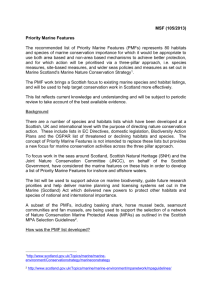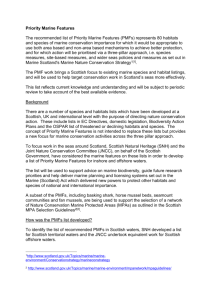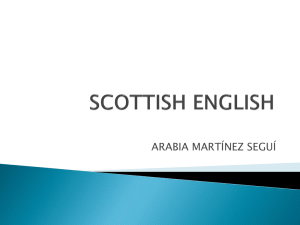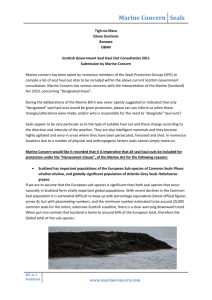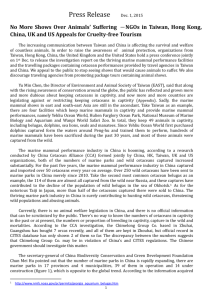Open - The Scottish Government
advertisement
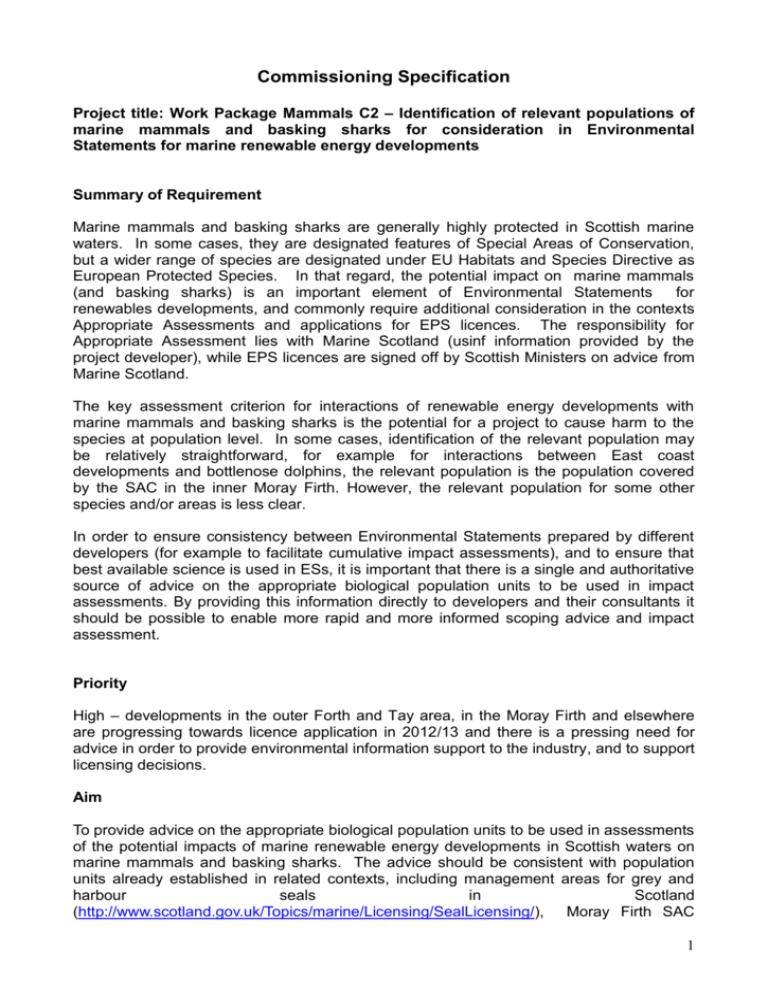
Commissioning Specification Project title: Work Package Mammals C2 – Identification of relevant populations of marine mammals and basking sharks for consideration in Environmental Statements for marine renewable energy developments Summary of Requirement Marine mammals and basking sharks are generally highly protected in Scottish marine waters. In some cases, they are designated features of Special Areas of Conservation, but a wider range of species are designated under EU Habitats and Species Directive as European Protected Species. In that regard, the potential impact on marine mammals (and basking sharks) is an important element of Environmental Statements for renewables developments, and commonly require additional consideration in the contexts Appropriate Assessments and applications for EPS licences. The responsibility for Appropriate Assessment lies with Marine Scotland (usinf information provided by the project developer), while EPS licences are signed off by Scottish Ministers on advice from Marine Scotland. The key assessment criterion for interactions of renewable energy developments with marine mammals and basking sharks is the potential for a project to cause harm to the species at population level. In some cases, identification of the relevant population may be relatively straightforward, for example for interactions between East coast developments and bottlenose dolphins, the relevant population is the population covered by the SAC in the inner Moray Firth. However, the relevant population for some other species and/or areas is less clear. In order to ensure consistency between Environmental Statements prepared by different developers (for example to facilitate cumulative impact assessments), and to ensure that best available science is used in ESs, it is important that there is a single and authoritative source of advice on the appropriate biological population units to be used in impact assessments. By providing this information directly to developers and their consultants it should be possible to enable more rapid and more informed scoping advice and impact assessment. Priority High – developments in the outer Forth and Tay area, in the Moray Firth and elsewhere are progressing towards licence application in 2012/13 and there is a pressing need for advice in order to provide environmental information support to the industry, and to support licensing decisions. Aim To provide advice on the appropriate biological population units to be used in assessments of the potential impacts of marine renewable energy developments in Scottish waters on marine mammals and basking sharks. The advice should be consistent with population units already established in related contexts, including management areas for grey and harbour seals in Scotland (http://www.scotland.gov.uk/Topics/marine/Licensing/SealLicensing/), Moray Firth SAC 1 population of biottlenose dolphins, population units used for the assessment of the significance of by-catch of harbour porpoise in the ICES area, and population units for minke whale and other cetaceans used by the Internatioinal Whaling Commission, ASCOBANS and in other fora. The project should provide full justification for the species and population units selected. Objectives The project will: Provide information on the structure of populations of seals, cetaceans and basking sharks in Scottish waters, and more widely where the range of biologically meaningful population units of species occurring in Scottish waters extends beyond Scottish waters. Concentrate on species that occur regularly and in significant numbers in Scottish waters, rather than species which occur irregularly in small numbers and which may be considered as “strays”. Provide advice on the relevant population units of seals, cetaceans and basking sharks applying to areas of serch for renewables developments identified in Marine Scotland Scoping Studies for wind (2011), wave (2012) and tidal stream (2012) energy. Promote Marine Scotland's role as the provider of high quality support to the renewables industry, at the same time balancing our role as the environmental managers of Scotland's seas. Approach The outputs of this project should include at least: 1. A review of the biologically meaningful populaton structures of seals and cetaceans in Scottish waters. 2. A review of the population units of seals and cetaceans identified in other contexts. 3. Advice on the population units to be used in site characterisation for renewablke energy developments in areas of search identified in recent Scoping Studies for wind, wave and tidal stream energy. Outputs The contractor will be expected to provide the Scottish Government with the following outputs: A report which provides the data requirements as set out in 1 – 2 above. Policy Customer/Project Manager The policy customer will be Phil Alcock from Marine Planning & Policy Division. Phil.alcock@scotland.gsi.gov.uk (0131 244 6602) Research Adviser The relevant scientific advisor is Dr Ian Davies (Marine Scotland Science). 2 Ian.davies@scotland.gsi.gov.uk (01224 295 468) Duration of project Complete by 31 April 2012 – Delivery of final report 3


